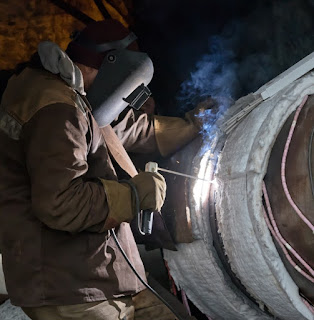Arc welding processes are based on fusion. Fusion requires closeness and cleanliness at the atomic level, both of which can be achieved by shielding the molten puddle with gas or slag. There are several types of arc welding processes as follows:
Shielded Metal Arc Welding (SMAW)
An electric arc is produced between the end of a coated metal electrode and the steel components to be welded (Figure 1). The electrode is a filler metal covered with a coating. The electrode’s coating has two purposes:
- It forms a gas shield to prevent impurities in the atmosphere from getting into the weld, and
- It contains a flux that purifies the molten metal.
SMAW is almost exclusively a manual arc welding process. Because of its versatility and simplicity, it is particularly dominant in the maintenance and repair industry. The most common quality problems associated with SMAW include weld spatter, porosity, poor fusion, shallow penetration and cracking.
 |
| Figure 1: Shielded Metal Arc Welding (SMAW) |
Gas Metal Arc Welding (GMAW)
Gas Metal Arc Welding (GMAW) is fast and economical. As shown in Figure 2, a continuous wire is fed into the welding gun. The wire melts and combines with the base metal to form the weld. The molten weld metal is protected from the atmosphere by a gas shield that is fed through a conduit to the tip of the welding gun. The process may be semi- automatic or automated. It cannot be used in a windy environment as the loss of the shielding gas from air flow will produce porosity in the weld.
 |
| Figure 2: Gas Metal Arc Welding (GMAW) |
Flux Cored Arc Welding (FCAW)
Flux Cored Arc Welding (FCAW) is similar to the GMAW process and is usually performed by semi/full automatic methods. The difference is that the filler wire has a center core that contains flux (see Figure 3). With this process it is possible to weld with or without a shielding gas, which makes it useful for exposed conditions where a shielding gas may be affected by the wind.
 |
| Figure 2: Flux Cored Arc Welding (FCAW) |
Submerged Arc Welding (SAW)
Submerged Arc Welding (SAW) is usually performed by semi/full automatic or handheld methods. As shown in Figure 4, it uses a continuously fed filler metal electrode. The weld pool is protected from the surrounding atmosphere by a blanket of granular flux fed at the welding gun. It results in a deeper weld penetration than the other processes. However, only flat or horizontal positions may be used.
 |
| Figure 4: Submerged Arc Welding (SAW) |
Process Selection
Selection of the welding process is typically left to the contractor. The characteristics of the various processes are:
- SAW: long, big, semi/full automatic or handheld methods.
- FCAW: semi/full automatic methods.
- SMAW: small, miscellaneous, repair, tack welds and handheld method.
- GMAW: semi/full automatic methods in shop.
https://hotfoilehs.com | 609.588.0900
Reprinted from the Michigan Department of Transportation Field Manual for Structural Welding.





